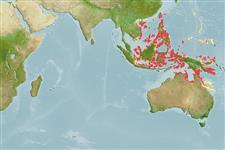>
Gobiiformes (Gobies) >
Gobiidae (Gobies) > Gobiinae
Etymology: Eviota: No etymology given, suggested by Christopher Scharpt: from Latin 'eu' for 'true' and 'iota' for anything very small, in combination 'truly very small' referring to it as being the smallest vertebrate at the time it has benn described by Jenkins (thus, making the suggestion by Scharpt plausible.
More on authors: Lachner & Karnella.
Environment: milieu / climate zone / depth range / distribution range
Ecología
marino asociado a arrecife; rango de profundidad 1 - 15 m (Ref. 90102). Tropical; 25°N - 24°S, 105°E - 154°E
Western Pacific: Japan (Yaeyama Islands), Palau, Philippines, and Indonesia; east to Papua New Guinea, Vanuatu and New Caledonia; south to Australia (Great Barrier Reef).
Tamaño / Peso / Age
Maturity: Lm ? range ? - ? cm
Max length : 3.5 cm SL macho / no sexado; (Ref. 48637)
Short description
Claves de identificación | Morfología | Morfometría
Espinas dorsales (total) : 7; Radios blandos dorsales (total) : 8 - 10; Espinas anales: 1; Radios blandos anales: 8 - 10. Characterized by translucent with broad red to brown, internal midlateral stripe from head to caudal fin base; 3-5 white to yellowish spots posteroventrally above base of anal fin; caudal fin base with presence of diagnostic black hour-glass shaped mark; all pectoral rays unbranched; longitudinal scale series 22-24; ctenoid scales, none on head, nape and base of pectoral fin; separated pelvic fins, thin membrane joining bases; fourth pelvic ray with 4-9 branches; depth of body 5.0-5.6 in SL (Ref. 90102).
Inhabits clear coastal reefs and protected outer reef coral habitats. Usually at moderate depths of 10 meters or more, swimming near sponges or corals when feeding on plankton (Ref. 48637). Hovers in groups above branching corals of protected reefs (Ref. 9710).
Life cycle and mating behavior
Madurez | Reproducción | Puesta | Huevos | Fecundidad | Larva
Myers, R.F., 1991. Micronesian reef fishes. Second Ed. Coral Graphics, Barrigada, Guam. 298 p. (Ref. 1602)
IUCN Red List Status (Ref. 130435: Version 2024-2)
Can't connect to MySQL database (fbapp). Errorcode: Too many connections
